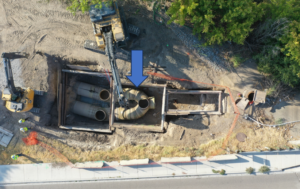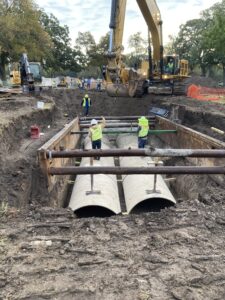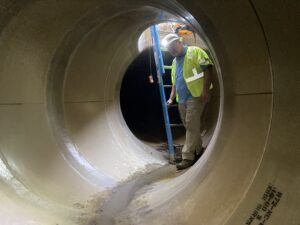Video: Dallas Water Utilities Thinks Outside the Circle to Solve Pipeline Failure
When a failure in the 54-inch Five Mile Creek interceptor sewer formed a sinkhole in the middle of a park, Dallas Water Utilities (DWU) was faced with a difficult challenge. DWU had to find a creative way to overcome the obstacles associated with creating a new larger capacity bypass pipeline to replace the failing pipeline through the City of Dallas Glendale Park.
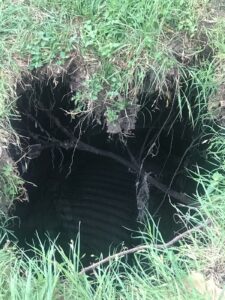
The initial plan was to construct a single 72-inch pipeline to connect upstream and downstream to the Five Mile Creek interceptor sewer. But the plan had to change when it was determined that the traditional circular 72-inch pipe would end up sticking out of the ground at a creek crossing, and there would be less than 1-foot of cover in areas where park improvements were being planned.
After further assessment, the project team decided to split the flow through that section into two parallel pipelines. However, the team was not able to identify a combination of parallel configurations using circular pipes or typical non-circular pipes, like elliptical or box shaped, that would meet flow capacity and spatial requirements. This is where DWU, with help from Freese and Nichols, took an innovative approach.
The project team developed a design using an atypical-non-circular Glass Fiber Reinforced Polymer (GFRP) pipe. The result was a novel implementation of two parallel GFRP semi-elliptical arch pipes.
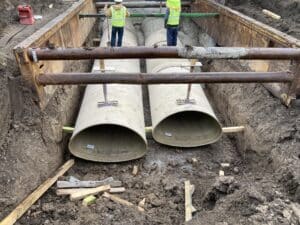
“The only thing we had to figure out was how to transition from the large circular pipes into the semi-elliptical arch pipe without using a large junction structure,” said Mike Hagen, Transmission and Utilities, Dallas.
To do this, the team ended up using a bifurcation wye fitting to make the transition work. The wye fitting merges the flow from the two pipes into one main pipe or vice versa.
“All the flow is contained within the pipe,” Mike said. “Using the wye fitting allowed us to transition the flow without the typical head loss, infiltration, or future corrosion issues associated with junction structures and manholes. By using fittings with access ways to complete the transitions along the pipeline we were able to create a continuous GRFP pipe system.”
New construction (direct-bury) of semi-elliptical arch pipe in new gravity wastewater pipeline construction is not common in the United States. In fact, this is the first project in Texas involving the direct bury of a U.S. manufactured GFRP semi-elliptical arch pipe.
“I’m proud of what the team accomplished,” Mike said. “DWU and the team were able to overcome every roadblock to get this pipeline successfully built and operational. With this being a first of its kind project, we laid the groundwork for others to apply this approach for similar shallow large wastewater interceptor replacement projects.”
The new pipeline was substantially completed in September 2023.
Project at a Glance
Project Name: Glendale Park Emergency Five Mile Interceptor Replacement
Owner: Dallas Water Utilities
DWU Engineering Program Administrator: Rishi Bhattarai, PE
DWU Senior Project Manager: Joe Felipe, PE
DWU Senior Engineer: Clayton Buehrle, PE
DWU Senior Project Coordinator East: Michael Warren
DWU Construction Inspector: Daniel Bosquez Guajardo
Freese and Nichols Project Manager: Mike Hagen, PE, PACP
Freese and Nichols Principal-in-Charge: Scott Maughn, PE
Freese and Nichols BIM/CAD Designer: Joe Perez
Location: Dallas, Texas


